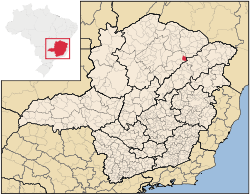
Josenópolis
Encyclopedia

Minas Gerais
Minas Gerais is one of the 26 states of Brazil, of which it is the second most populous, the third richest, and the fourth largest in area. Minas Gerais is the Brazilian state with the largest number of Presidents of Brazil, the current one, Dilma Rousseff, being one of them. The capital is the...
. In 2007 the population was 4,440 in a total area of 536 km². It became a municipality in 1997.
Location and Distances
Josenópolis is located in the foothills of the Serra do Espinhaço mountains southeast of Montes ClarosMontes Claros
Montes Claros is a city located in northern Minas Gerais state, in Brazil. The estimated population in 2010 was 412,284 inhabitants and the total area of the municipality was 3,470 km²...
at an elevation of 692 meters. It is north of the Rio Jequitinhonha and is connected by dirt road to other population centers. The Rio Vacaria, a tributary of the Rio Jequitinhonha, flows into the Jequitinhonha. Neighboring municipalties are: Grão Mogol
Grão Mogol
Grão Mogol is a Brazilian municipality located in the north of the state of Minas Gerais. In 2007 the population was 14,954 in a total area of 3,890 km². The elevation is 829 meters. It became a municipality in 1840.-Location and Distances:...
, Padre Carvalho
Padre Carvalho
Padre Carvalho is a Brazilian municipality located in the north of the state of Minas Gerais. In 2007 the population was 5,828 in a total area of 450 km². It became a municipality in 1997.-Location and Distances:...
, and Coronel Murta
Coronel Murta
Coronel Murta is a Brazilian municipality located in the northeast of the state of Minas Gerais. Its population as of 2007 was estimated to be 9,120 people living in a total area of 813 km². The city belongs to the mesoregion of Jequitinhonha and to the microregion of Araçuaí...
.
Josenópolis is part of the statistical microregion of Grão Mogol.
Economic activities
The most important economic activities are cattle raising (4,000 head in 2006) and subsistence agriculture. The GDP in 2005 was R$ 10,399,000. The most important agricultural crops are bananas, coffee, peanuts, sugarcane, and corn. In the rural area there were 446 producers. The total area of agricultural land was 15,000 hectares in 2006, of which 1,000 ha. were in crops. As of 2006 there were only 02 tractors. In the urban area there were no banking agencies in 2006.Health and education
This municipality is isolated from major population centers and suffers from drought and poor soils.- Municipal Human Development IndexHuman Development IndexThe Human Development Index is a composite statistic used to rank countries by level of "human development" and separate "very high human development", "high human development", "medium human development", and "low human development" countries...
: .610 (2000) - State ranking: 819 out of 853 municipalities as of 2000
- National ranking: 4,485 out of 5,138 municipalities as of 2000
The highest ranking municipality in Minas Gerais in 2000 was Poços de Caldas
Poços de Caldas
Poços de Caldas is a city and municipality in south-western Minas Gerais state, Brazil, in the microregion of the same name. Its estimated population in 2009 was 151,449 inhabitants...
with 0.841, while the lowest was Setubinha
Setubinha
Setubinha is a municipality in the northeast of the Brazilian state of Minas Gerais. As of 2007 the population was 10,834 in a total area of 536 km². The elevation is 729 metres. It is part of the IBGE statistical microregion of Teófilo Otoni...
with 0.568. Nationally the highest was São Caetano do Sul
São Caetano do Sul
São Caetano do Sul is a city in São Paulo state in Brazil, located in the Greater São Paulo Metropolitan Area. It is the city with the highest per capita income in Brazil and it also has the highest Human Development Index .-Geography:São Caetano do Sul is located on a plateau that is part of the...
in São Paulo with 0.919, while the lowest was Setubinha.
- Degree of urbanization: 47.50% (2000)
- Infant mortality rate: 24.39 (2000) The rate for Minas Gerais was 17.40; the rate for Brazil was 18.91.
- Illiteracy rate: 40.62% (15 years old or older)(Data from 2000) The rate for Minas Gerais was 11.96; the rate for Brazil was 13.63
- Urban area covered by sewage system: 1.50%--the rate for Minas Gerais was 81.39%
- Health centers and hospitals: 01 health center. There were no hospitals.

